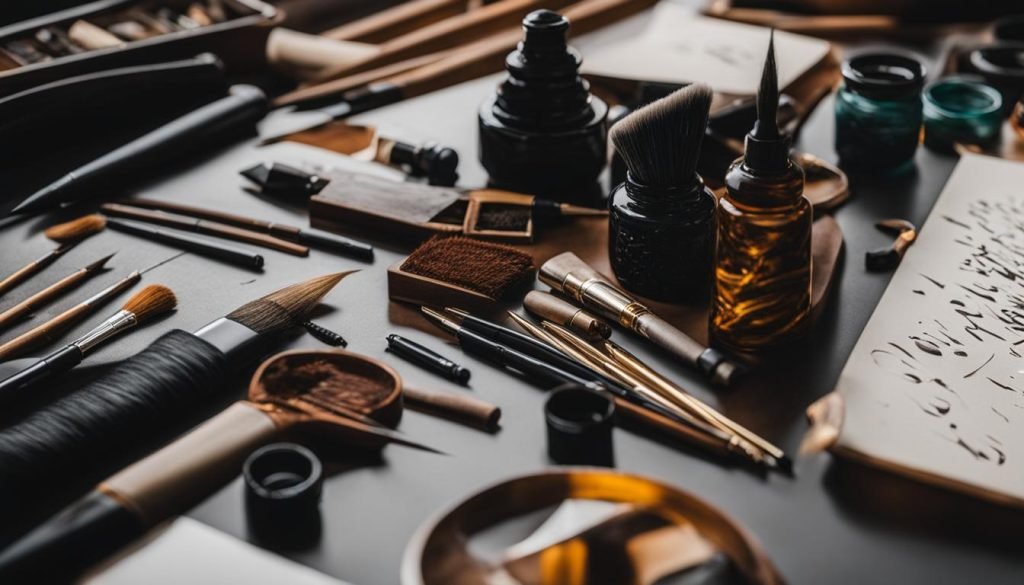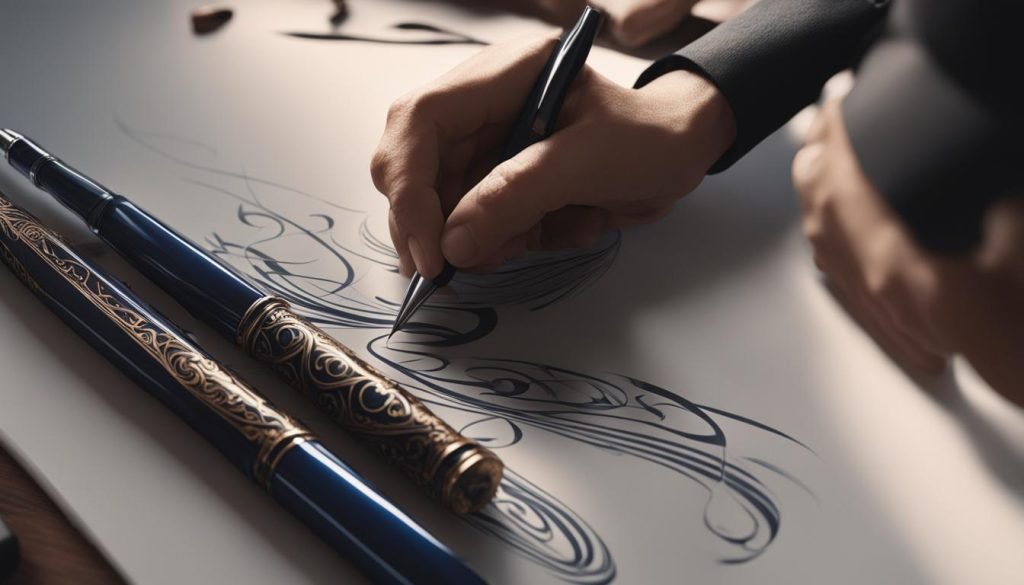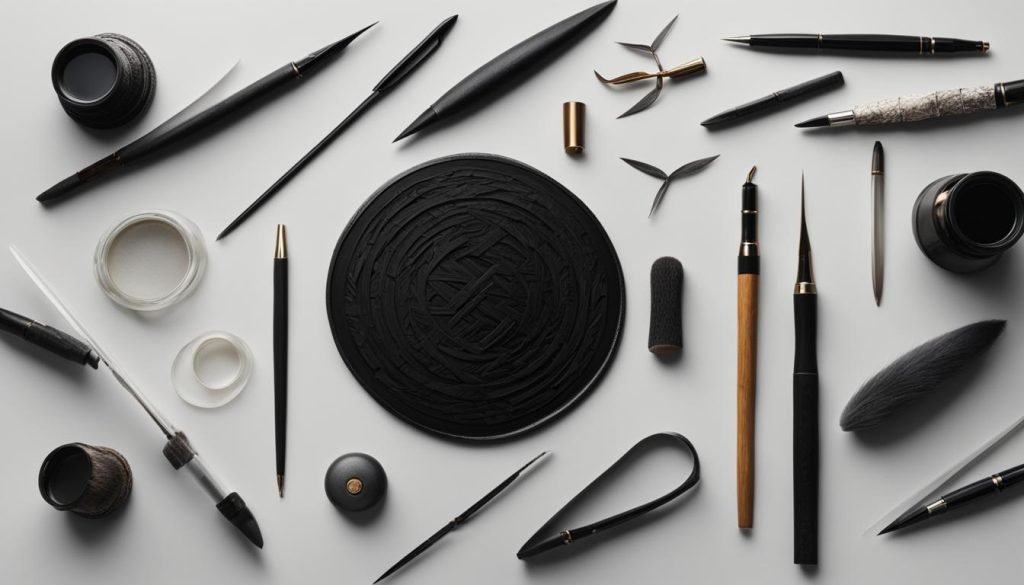Calligraphy Practice for Flexibility: Unlock the Secrets to a Versatile Hand!
Welcome to the world of calligraphy! If you’re looking to improve your calligraphy skills and add a touch of versatility to your work, then practicing for flexibility is the way to go. Developing a flexible hand and mastering flexible strokes can greatly enhance your artistic expression and help you explore new possibilities in calligraphy.
In this section, we will dive into various calligraphy techniques, drills, and exercises that can improve your flexibility. These practices will not only enhance the aesthetic quality of your work but also allow you to develop your own unique style. So let’s get started and unlock your creative potential!
Key Takeaways:
- Practicing for flexibility can diversify your calligraphy style.
- Improving flexibility in calligraphy requires techniques, drills, and exercises.
- A flexible hand and flexible strokes contribute to the artistic quality of calligraphy.
- Using proper pen hold and maintaining good posture are vital for achieving flexibility.
- Experimenting with different calligraphy tools can aid in developing flexibility.
Understanding the Importance of Flexibility in Calligraphy

In the world of calligraphy, flexibility plays a crucial role in elevating the artistic quality of your work. Having a flexible hand and being able to execute flexible strokes not only enhances the aesthetic appeal but also allows you to explore and experiment with different styles and techniques. Let’s delve into the significance of flexibility in calligraphy and understand the benefits it brings to your craft.
Flexibility in calligraphy allows you to create unique letterforms and add a personal touch to your compositions. By bending the rules of traditional scripts and embracing the freedom of flexible strokes, you can infuse your work with individuality and flair. The ability to manipulate the thickness and shape of your letters through flexible movements opens up a world of creative possibilities, enabling you to develop a distinct style that sets you apart.
Furthermore, the importance of a flexible hand extends beyond aesthetics. A flexible hand reduces strain and fatigue, enabling you to practice calligraphy for longer periods without discomfort. It also improves control and precision, allowing you to execute intricate details and delicate flourishes with ease. Developing flexibility in calligraphy is not only about producing visually stunning work but also about cultivating a sustainable and enjoyable practice.
The Benefits of Flexibility in Calligraphy:
- Creation of unique and personalized letterforms
- Freedom to explore different calligraphy styles and techniques
- Reduced strain and increased comfort during practice
- Improved control and precision in executing intricate details
- Enhanced aesthetic appeal and artistic quality of your work
Techniques for Developing Flexibility in Calligraphy

In order to improve your flexibility in calligraphy, it’s important to incorporate various techniques and exercises into your practice routine. These techniques are designed to target different aspects of flexibility in calligraphy and help you achieve more fluid and versatile strokes. By dedicating time to these exercises, you can enhance your overall calligraphy skills and develop a unique style. Here are some effective techniques for developing flexibility in calligraphy:
Drills and Exercises
One of the key ways to improve flexibility in calligraphy is through drills and exercises that specifically target the muscles and movements involved in writing. These drills can include repetitive motions and patterns that help to build muscle memory and increase control over your strokes. For example, practicing figure eights, loops, and spirals can help loosen your hand and enhance flexibility.
Another beneficial exercise is the “continuous line” drill, where you continuously create fluid, uninterrupted lines without lifting your pen off the paper. This drill not only improves flexibility but also helps with maintaining consistent pressure and control. Regularly incorporating these drills into your practice sessions can significantly improve your flexibility in calligraphy.
Hand Strengthening
Developing strength in your hand is crucial for achieving flexibility in calligraphy. Stronger hand muscles allow for better control and precision when executing various calligraphy strokes. Simple hand strengthening exercises, such as squeezing a stress ball or using hand grip devices, can be beneficial for building strength.
Additionally, using larger calligraphy tools or brush pens that require more pressure and control can help strengthen your hand muscles. By gradually incorporating these tools into your practice, you’ll be able to develop both strength and flexibility in your hand, allowing for more dynamic and creative strokes.
Consistency and Patience
Improving flexibility in calligraphy requires consistency and patience. It’s important to set aside dedicated practice time regularly, even if it’s just a few minutes each day. Consistency allows your muscles to adapt and grow stronger over time, leading to improved flexibility.
It’s also essential to be patient with yourself as you work on developing flexibility. Progress may not be immediate, but with regular practice and perseverance, you will start to notice improvements in your flexibility and overall calligraphy skills.
Summary
Developing flexibility in calligraphy requires incorporating various techniques and exercises into your practice routine. Drills and exercises that target specific calligraphy movements can improve flexibility, while hand strengthening exercises and using larger calligraphy tools can help build strength in your hand. Consistency and patience are key in achieving flexibility, so be sure to dedicate regular practice time and allow yourself time to progress. By focusing on these techniques, you can enhance your calligraphy skills and develop a more versatile and expressive style.
The Role of Pen Hold and Posture in Flexibility

In the world of calligraphy, the way you hold your pen and maintain your posture can greatly impact the flexibility of your hand. Proper pen hold and posture are essential for achieving fluid and flexible strokes in your calligraphic creations. Let’s explore the importance of pen hold and posture in developing flexibility in calligraphy.
Pen Hold for Flexibility in Calligraphy
The way you hold your pen can make a significant difference in the flexibility of your hand. A loose grip allows for greater movement and control, enabling you to create varied and flexible strokes. Avoid gripping the pen too tightly, as it can restrict the natural movement of your hand and limit the flexibility of your strokes.
“The key is to find a grip that feels comfortable and allows for dexterity and flexibility in your movements.”
Posture for Flexible Hand in Calligraphy
Maintaining a proper posture is equally crucial for achieving flexibility in calligraphy. Sitting up straight with your feet flat on the floor helps align your body and promotes better hand control. Your arms and wrists should be relaxed, allowing for smooth and fluid movements. Avoid hunching over or slouching, as it can cause tension in your muscles and hinder flexibility.
Ergonomics for Flexibility in Calligraphy
Considering ergonomics while practicing calligraphy can further enhance flexibility in your hand. Using a slanted writing surface or an angled pen holder can help improve hand comfort and flexibility. Experiment with different writing tools and accessories to find what works best for you. Taking regular breaks and stretching your hand and arm muscles can also prevent stiffness and promote flexibility in the long run.
To summarize, the correct pen hold and posture are vital for developing flexibility in calligraphy. By adopting a loose grip, maintaining proper posture, and considering ergonomics, you can achieve more fluid and flexible strokes in your calligraphic work. Practice these techniques consistently to enhance the flexibility of your hand and unleash your creative potential in calligraphy.
Exploring Different Calligraphy Tools for Flexibility

When it comes to calligraphy, having the right tools can make all the difference in enhancing your flexibility. By using the appropriate calligraphy tools, you can achieve flexible strokes and experiment with various styles. Let’s explore some versatile and flexible tools that can take your calligraphy practice to the next level.
One of the most popular tools for achieving flexibility in calligraphy is the brush pen. Brush pens are designed with a flexible tip that allows for varying line widths and expressive strokes. They offer a range of possibilities for creating dynamic and fluid letterforms. Whether you prefer a firm or soft brush tip, brush pens come in different variations to suit your style and level of flexibility.
Another tool worth exploring is the pointed pen. Pointed pens, such as dip pens or fountain pens with flexible nibs, provide excellent control and flexibility. The nibs can be adjusted to different degrees of flexibility, allowing you to create elegant and varied strokes. With consistent practice, you can achieve beautiful hairline strokes and bold swells, adding depth and character to your calligraphy.
In addition to brush pens and pointed pens, there are other versatile tools that offer flexibility in calligraphy. These include ruling pens, folded pens, and automatic pens. Each tool has its unique characteristics and can be used to create different effects and styles. Exploring these tools and experimenting with their capabilities will broaden your range of flexibility in calligraphy.
Comparison of Calligraphy Tools for Flexibility
| Tool | Flexibility Range | Suitable for |
|---|---|---|
| Brush Pen | Flexible | Creating expressive and dynamic strokes, experimenting with different letterforms |
| Pointed Pen | Adjustable flexibility | Achieving elegant hairline strokes and bold swells, adding depth to calligraphy |
| Ruling Pen | Variable flexibility | Creating parallel lines, geometric designs, and unique textures |
| Folded Pen | Flexible | Producing thick and thin lines with varying pressure, experimenting with abstract calligraphy |
| Automatic Pen | Fixed flexibility | Creating consistent strokes, perfect for beginner calligraphers |
By exploring and experimenting with different calligraphy tools, you can discover new techniques and possibilities for achieving flexibility in your work. Whether you prefer the expressive strokes of a brush pen, the controlled elegance of a pointed pen, or the unique effects of other versatile tools, each tool offers its own benefits and challenges. Remember to practice regularly and have fun with your calligraphy journey!
Incorporating Flexibility into Different Calligraphy Styles
In the world of calligraphy, flexibility plays a vital role in creating diverse and captivating letterforms. Whether you’re practicing traditional scripts or experimenting with contemporary styles, adapting flexibility to various calligraphy styles can greatly enhance the artistic expression of your work.
Each calligraphy script has its own unique characteristics and letterforms that require different levels of flexibility. For example, when working with the elegant and flowing strokes of Copperplate calligraphy, a flexible hand becomes essential in achieving the delicate hairlines and bold downstrokes that define this script. On the other hand, a more rigid and controlled hand is often required for scripts like Gothic or Blackletter, where sharp angles and strong lines are prominent.
By understanding the demands of different calligraphy styles, you can tailor your practice to develop the required flexibility. Experimenting with different techniques, tools, and exercises will allow you to adapt and refine your strokes to match the specific letterforms of each script. Embracing flexibility in calligraphy opens up a world of possibilities, enabling you to create your own unique blend of traditional and contemporary styles.
Calligraphy Styles and Their Flexibility
| Calligraphy Style | Features | Required Flexibility |
|---|---|---|
| Copperplate | Elegant, flowing strokes | High flexibility for delicate hairlines and bold downstrokes |
| Gothic/Blackletter | Sharp angles, strong lines | Controlled flexibility for precise and rigid strokes |
| Italic | Sloping and graceful letterforms | Moderate flexibility for smooth transitions and ligatures |
| Brush Calligraphy | Dynamic and expressive strokes | Variable flexibility for thick and thin lines with brush pens |
Adapting flexibility to different calligraphy styles allows you to infuse your work with a sense of individuality and experimentation. It enables you to push the boundaries of traditional lettering and explore new possibilities in expressing your artistic voice. So whether you’re mastering the timeless elegance of Copperplate or pushing the boundaries of modern brush calligraphy, embracing flexibility will unlock a world of creativity and personalization in your calligraphic journey.
Developing a Personal Style with Flexibility
In the art of calligraphy, developing a personal style is essential to stand out and express your individuality. Flexibility plays a crucial role in achieving this unique flair. By embracing flexible strokes, you can add a touch of creativity and personal touch to your calligraphic compositions.
Flexible strokes allow you to experiment with various letterforms, creating a dynamic and captivating visual impact. It enables you to break away from traditional conventions and explore new possibilities in your work. Whether you prefer a more traditional style or a modern twist, flexibility provides the freedom to adapt and evolve your calligraphy.
To develop your personal style with flexibility, start by practicing different techniques that enhance the flexibility of your hand. Engage in exercises and drills designed to promote flexibility, such as rhythmic strokes and continuous loops. These exercises will help you gain control over your hand movements and enable you to achieve more fluid and expressive strokes.
Additionally, don’t be afraid to experiment with various calligraphy tools. Brush pens, for example, offer versatility and flexibility in stroke width, allowing you to create unique and dynamic letterforms. Explore different scripts and alphabets, adapting flexibility to suit each style. Embrace the imperfections and unique qualities that come with flexible strokes, as they add character and personality to your calligraphy.
Table: Quotes from Calligraphy Masters
| Calligraphy Master | Quote |
|---|---|
| Wang Xizhi | “Flexibility is the key to unlocking the true beauty of calligraphy.” |
| Sei Shōnagon | “In flexible strokes, lies the essence of calligraphy.” |
| Edward Johnston | “Develop your own style by embracing the freedom and expression that comes with flexible strokes.” |
“Flexibility is the key to unlocking the true beauty of calligraphy.” – Wang Xizhi
Remember to practice regularly and maintain your flexibility. Incorporate hand exercises and warm-up routines into your daily calligraphy practice to prevent stiffness and ensure that your strokes remain fluid and expressive. As you develop your personal style, continue to challenge yourself and push the boundaries of what is possible with flexible strokes. Embrace the journey of self-expression and watch your calligraphy flourish with individuality and flair.
Tips for Maintaining Flexibility in Calligraphy Practice
Practicing calligraphy requires not only a keen sense of artistic expression but also a flexible hand. Flexibility allows you to achieve fluid and graceful strokes, adding a unique touch to your letterforms. However, maintaining flexibility in calligraphy practice is essential to prevent stiffness and ensure long-term progress. Here are some tips to help you keep your hand flexible and nimble:
- Regular hand exercises: Incorporate specific hand exercises into your daily calligraphy practice routine. These exercises help warm up your hand, fingers, and wrist, promoting flexibility and preventing stiffness. Experiment with finger stretches, hand squeezes, and wrist rotations to keep your joints mobile and flexible.
- Practice proper warm-up routines: Before diving into your calligraphy work, take a few minutes to warm up your hand and fingers. Start with gentle stretching exercises, such as making a fist and then slowly opening your hand. Gradually increase the intensity and speed of your warm-up exercises to wake up your muscles and prepare them for the intricate movements of calligraphy.
- Take breaks and stretch: Calligraphy practice can be intense, especially when you’re deeply focused on perfecting your strokes. Remember to take regular breaks during lengthy sessions and stretch your hand and fingers. Simple stretches, such as spreading your fingers wide or gently bending them backward, can alleviate tension and maintain flexibility.
Additionally, it’s important to create an ergonomic workspace that supports flexibility in calligraphy practice. Ensure that your desk and chair are at the correct height, allowing your arm, wrist, and hand to move freely without strain. Pay attention to your posture and avoid hunching over your work, as this can lead to stiffness and discomfort.
By incorporating these tips into your calligraphy practice routine, you can maintain flexibility in your hand and prevent stiffness. Remember, flexibility is a key component of achieving exquisite and unique strokes in calligraphy, so take care of your hand to continue improving your skill and artistic expression.
Overcoming Challenges in Developing Flexibility
Developing flexibility in calligraphy can be a challenging endeavor, but by addressing common obstacles and troubleshooting flexibility issues, you can continue your journey towards achieving more fluid and versatile strokes. Let’s explore some of the challenges you may encounter and practical solutions to overcome them.
Challenge 1: Stiffness and Tension
One of the main challenges in developing flexibility is dealing with stiffness and tension in the hand and arm. This can hinder the smoothness and fluidity of your strokes. To address this, it’s important to incorporate regular hand exercises and stretches into your practice routine. These exercises can help relax your muscles, increase flexibility, and alleviate stiffness. Consider trying finger stretches, wrist rotations, and hand massages to warm up your hand before each practice session.
Challenge 2: Lack of Control
Another challenge you may face is a lack of control over your strokes, especially when attempting more intricate and flexible letterforms. To tackle this, focus on practicing controlled and deliberate movements. Start with simpler strokes and gradually increase the complexity as you gain more control. Breaking down complex letterforms into smaller components and practicing them individually can also help in mastering the desired flexibility.
Challenge 3: Inconsistent Pen Pressure
Consistency in pen pressure is crucial for achieving uniform and flexible strokes. However, maintaining a consistent pressure can be challenging, especially when transitioning between different stroke variations. One solution is to practice drills that specifically target pen pressure control. Use guidelines and grids to ensure even pressure distribution. With practice, you’ll develop a better sense of control and will be able to execute flexible strokes with more accuracy.
Remember, challenges in developing flexibility are part of the learning process. Embrace them as opportunities to grow and improve. By incorporating targeted exercises, practicing deliberate strokes, and focusing on control, you’ll gradually overcome these obstacles and enhance your calligraphy skills. Keep pushing yourself, and with perseverance, you’ll develop the flexibility needed to create stunning and unique pieces of calligraphic art.
Conclusion
Developing flexibility in calligraphy is essential for improving your artistic skills and diversifying your style. By incorporating various techniques, exercises, and the right tools, you can achieve flexible strokes and unlock new possibilities in your calligraphy work.
Regular practice is key to improving flexibility in calligraphy. Make sure to dedicate time to specific hand exercises and stretches to prevent stiffness and maintain flexibility. By incorporating these exercises into your warm-up routine, you can ensure that your hand remains agile and adaptable.
Throughout your calligraphy journey, you may encounter challenges in developing flexibility. It’s important to address and overcome these obstacles by troubleshooting and seeking practical solutions. Remember that perseverance and patience are crucial to achieving the level of flexibility you desire.
By embracing flexibility in your calligraphy practice, you can infuse your work with your own personal flair and unique style. Experiment with different scripts and letterforms, explore the versatility of flexible strokes, and allow your creativity to flourish. With time, practice, and dedication, you will see significant improvement in your calligraphy as you continue to enhance and diversify your style through flexibility.
FAQ
What is the importance of flexibility in calligraphy?
Flexibility in calligraphy is crucial for enhancing the artistic quality of your work and creating unique letterforms. It allows you to add your personal flair and diversify your style.
How can I improve flexibility in calligraphy?
You can improve flexibility in calligraphy through various techniques and exercises. Hand exercises, drills, and practice methods specifically designed to promote flexibility can be incorporated into your regular practice routine.
Does pen hold and posture affect flexibility in calligraphy?
Yes, proper pen hold and posture are important for achieving flexibility in calligraphy. Holding the pen correctly and maintaining a healthy posture can greatly affect the flexibility of your hand.
What calligraphy tools can aid in developing flexibility?
Using versatile tools like brush pens can help achieve flexible strokes in calligraphy. Different types of flexible tools have features that can cater to your preferred style and level of flexibility.
Can flexibility be incorporated into different calligraphy styles?
Yes, flexibility can be adapted to different calligraphy styles. Flexible strokes play a role in creating unique letterforms and can be adjusted to suit various scripts and alphabets.
How can flexibility contribute to developing a personal style in calligraphy?
Flexibility allows you to express your individuality through flexible strokes. It adds a unique flair to your calligraphic compositions, helping you develop and refine your personal style.
What are some tips for maintaining flexibility in calligraphy practice?
Regular hand exercises and stretches are important for maintaining flexibility and preventing stiffness. Proper warm-up routines and techniques can also help in maintaining flexibility over time.
What challenges may I face when developing flexibility in calligraphy?
Some common challenges in developing flexibility include overcoming stiffness and improving the flexibility of your strokes. Practical solutions and troubleshooting tips can help address these challenges.




